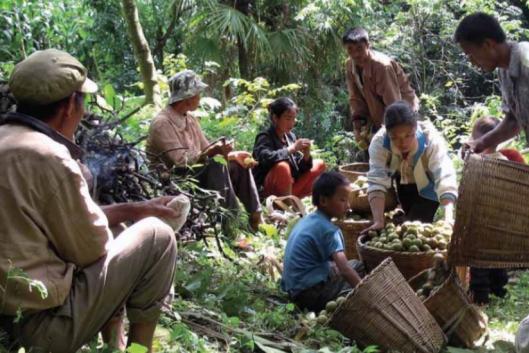Despite the harmful consequences of the export-oriented and polluting model of the agribusiness industry for local communities, workers and consumers' health, environments and the climate, much of the international debates on the world’s food supply continue to be focussed on increasing and expanding this model based on large-scale monocultures. The fact is that much of this expansion is taking place at the expense of natural diverse systems, in particular forests. It therefore also affects peasant and forest dependant peoples and populations. The alarming expansion of large-scale agribusiness in tropical forest regions threatens in turn the crucial contribution of forests to the diets and nutrition of people who directly and indirectly depend on forests around the world. At the same time, this model fuels and imposes an unhealthy homogenous and global consumption pattern at the expense of local diets and nutrition.
Most preserved forests worldwide have been used, maintained and defended for generations by the communities that directly depend on them. A fundamental reason for this is that forests and other vegetation types provide a steady supply of wild and cultivated fruit, vegetables, seeds, nuts, oils, roots, fungi, herbs, animal protein, among others. Animal proteins and fuel wood for subsistence and income generation contribute both directly and indirectly to food supply and nutrition in forest communities of sub-Saharan Africa, South-East Asia and Latin America. Apart from these direct roles, forests are a fundamental part of many interconnected cycles that are crucial for food production in these areas, such as soil formation, nutrient cycling, provision of green manure and drinkable water, pollination, biological diversity and micro-climate regulation, all of which further improve the nutrition of people who live in and with these lands. It is increasingly recognised that food from forests contributes to dietary diversity, which supports a shift away from calorific intake (quantity of food) as the primary metric for food consumption and towards a broader understanding of nutritionally-balanced diets (1).
In 2015, The Lancet Global Health journal, an open-access medical journal, published an article on research from the University of Cambridge, US, which looked at food and nutrients consumption patterns in 187 countries in 1990 and then again in 2010. The aim was to determine which countries had the world’s healthiest diets, according to nutrient quality of key food items and how those attend the needs of the human body (2).
Of the ten countries with the healthiest diets in terms of their nutritional quality, according to this journal, nine are located in Africa. Paradoxically, it is exactly this continent that is very often portrayed as one in need of foreign know-how and advice on how to grow food - often with external “solutions” based on the assumption that there is something inherently wrong about African diets, crops and farming. The three countries with the very best diets are among the world’s poorest according to the United Nations 2015 Human Development Index. Chad, which ranks 185th of 188 nations on the UN Index, has the world’s healthiest diet. After that come Sierra Leone and Mali, respectively 181st and 179th on the same Index (3). Other African nations among the countries with the most nutritious diets are, in descending order: The Gambia, Uganda, Ghana, Côte d’Ivoire, Senegal and Somalia. All together, Sub-Saharan Africa, particularly West Africa, ranked better than other regions considered as much wealthier in North America and Europe.
The study examines nutrition only in terms of the quality of the country’s diet, and does not speak about the quantity of food consumed. Nevertheless, it puts fundamental question marks about the way development agencies, institutions and donors in the food aid business with their programmes to promote “food security” affect existing rich food diets, especially when their food and development aid programmes are based on monoculture agribusiness. In the case of Africa, initiatives such as the Alliance for a Green Revolution in Africa (AGRA) and the G8 “New Alliance for Food Security and Nutrition”, which strongly promote the interests of corporate-controlled seeds, fertilizer and agro-chemicals at the expense of the rights and interests of smallholder communities, threaten local diversity and knowledge systems available for a rich and nutritional diet. Overall, the growing number of international projects on nutrition and agricultural initiatives in the Global South tend to prioritize global markets, commodity crops and foreign investment that takes control away from peasants and forest peoples and populations over their lands in order to expand an industrial agriculture model based on the heavy use of chemical inputs like agrotoxics. Moreover, transnational markets and foreign investments often promote consumption of unhealthy foods, such as snacks in Thailand and softdrinks in Mexico.
In order to respect and support healthy traditional diets – and therefore, local, peasant agriculture - there needs to be a radical change of path, very different from that prescribed by industrialized countries and corporate agribusiness, which control the industrial global food production system. We need to put an end to the dominance of export-based industrial forms of food production and respect peasant and forest communities’ local control and access over their lands, forests and livelihoods. Small-scale and diversified agricultural systems ensure food sovereignty, which in turn meets the nutritional and cultural needs of local communities. Food production based on local knowledges and cultures deserves support and priority when debating the world’s needs of secure food supplies, something that is still not the case for a large number of the world's population.
(1) Bhaskar Vira, Christoph Wildburger and Stephanie Mansourian (eds.) 2015, Forests and Food: Addressing Hunger and Nutrition Across Sustainable Landscapes, http://www.openbookpublishers.com/product/399/forests-and-food--addressing-hunger-and-nutrition-across-sustainable-landscapes
(2) Imamura, F, et al. 2015, Dietary quality among men and women in 187 countries in 1990 and 2010: a systematic assessment, The Lancet Global Health, http://www.thelancet.com/journals/langlo/article/PIIS2214-109X(14)70381-X/abstract
(3) http://www.joanbaxter.ca/2016/01/13/looking-for-healthy-eating-go-to-africa-2/
